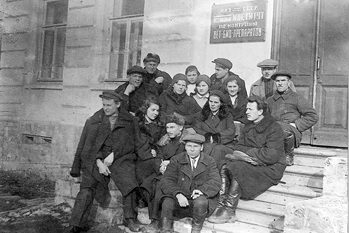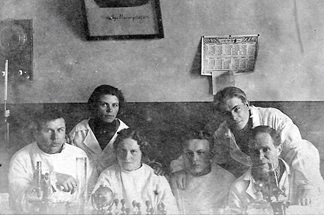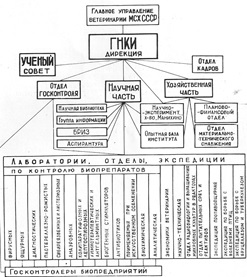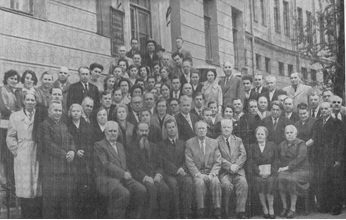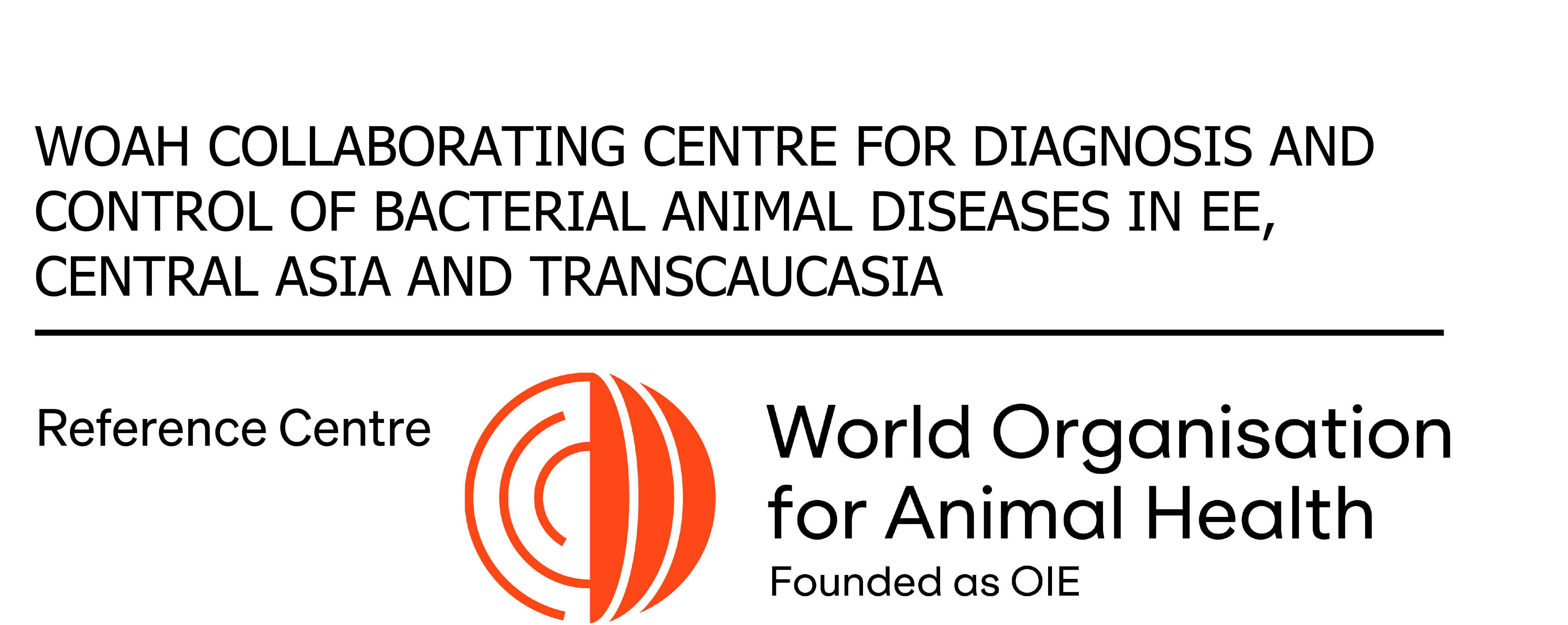Our history
The Russian State Center for Quality and Standardization of Veterinary Drugs and Feed (VGNKI)
Establishment and Development
The Soviet State Scientific and Control Institute for Veterinary Drugs Control (VGNKI) was first established on August 18, 1931 through the decree of the Collegium of the USSR People’s Commissariat of Agriculture as the Institute for Veterinary Biological Preparations Control. In this way an efficient system of state quality control of preparations, intended for the use in veterinary field and animal farming, was set up.
Kuzminki. Photo taken on doorsteps of the Institute
If prior to the October Revolution the manufacturing of biological products was more or less artisanal, large biofactories and biological-manufacturing plants producing vaccines, serums and diagnostic products started being constructed since 1930. Biological industry created at that time became a new veterinary branch. This industry of a new type demanded new technological processes as well as highly qualified staff to organize manufacturing, provide methodological guidance and do control on manufacturing process and quality of the products. All these tasks were entrusted to the State Scientific and Control Institute of Veterinary Drugs, which submitted directly to the General Directorate of Veterinary of the USSR People’s Commissariat of Agriculture. The Institute was explicitly requested to control all vaccination tools used in veterinary practice, to maintain and examine strains of microorganisms and matrixes serving as a main seed stock as well as to provide manufacturing establishments with them; to develop the unified standards for biological products manufacturing, control and use. The Institute was also assigned to carry out research on developing new drugs, improvement of the current ones and searching of more efficient ways of their use. The Institute developed guidelines on manufacturing, control and use of biological products since its early years. It also brought under regulation the serial manufacturing of high-quality biological products, including compulsory control on their purity, safety and potency.
As the Institute started its work in 1931, it employed a limited number of young researchers and consisted of 6 departments:
Department of Vaccine Control;
Department on Serum Control;
Department of Diagnostic Products Control;
Department of Control on Products against Ultra viruses;
Department of Anaerobic Products Control;
Department of Anthrax Products Control.
There was also Department of Cultural Media and Reagents established. The staff mostly included young researches under 30, however, fruitful in completing their tasks. They carried out laboratory assays, visited farms and biofactories and took part in international veterinary conferences.
First researches of the Institute, 1931 Alexeev, P. Sitnik-Ivanovskaya, F. Kagan, Ya. Kovalenko, V. Molochnikov, E. Boldov
There was a team of young and highly qualified specialists assembled. Many of them remained working in the Institute for a long time.
The number of employees significantly increased.
1934. The Laboratory of Paratyphoid and Leptospiral Bioproducts as well as the Biochemical Laboratory established.
1937. The Laboratory of Chemotherapeutic Products Control established.
Regional offices of the Institute were replaced with control laboratories created at each biofactory. These laboratories were headed by state controllers, appointed by the Ministry of Agriculture and submitting to GNKI.
According to the decree of the USSR Council of People's Commissars dated 1936 all organizations producing bacterial products for farm animals were subject to registration in GNKI whereas animal products were subject to systematic verification at the Institute. The Institute and its controllers gained the right to fully or partially suspend the manufacturing and output of products in case of reject detection. All this allowed us to sharply enhance a quality of the products. If the reject rate reached 42 % in the first year, it was decreased down to 16,7 % in 1934 and to 1,5-3,0 % in 1940.
Apart from control, scientific and manufacturing activities, the staff was engaged in approbation of veterinary and chemotherapeutic products, developed by other bodies. They visited farms to assist in diagnostics, treatment and prophylaxis of cattle, took part in veterinary conferences and congresses as well as seminars and trainings for young specialists.
In these years the researches of the Institute carried out a number of fundamental studies covering new technologies of veterinary drugs manufacturing and organization of their large scale production, which were highly evaluated by the government of the country.
During the Great Patriotic War, the Institute as well as the entire biological industry were given a task of providing military veterinary service and national economy as a whole with the sufficient amount of high-quality bioproducts. The staff of the Institute together with practitioners successfully accomplished this task. Doing that the Institute team was scattered throughout the country.
After conclusion of the War lots of them were given medals and orders, including the Medal "For Valiant Labour in the Great Patriotic War 1941–1945".
1945. Laboratory of Pasteurella Erysipelatous Products Control established.
1946. The Institute marked its first anniversary (15 years), already after the War.
The staff of the Institute actively took part in recovery of the damaged biological enterprises and training of the young doctors-microbiologists. These recovery operations were practically completed in 1952.
The Institute proposed a number of new valuable methods as well as injection products for animals:
Vaccines against viral infections:
tissue vaccine against rinderpest (V. Alexeyev);
aluminum hydroxide vaccine against sheep-pox and goat-pox (N. Lihachev);
Canine distemper, Aujeszky's disease and rabies;
Bacterial products:
vaccine against Paratyphus suum (M. Ivanov);
aluminum hydroxide vaccine against swine erysipelas (G. Glokhovtsev);
bivalent vaccine against bradsot and Enterotoxaemia infectiosa ovium (A. Lyaushkin);
precipitated vaccine against pasteurellosis of cattle, sheep and pigs (N. Nikiforova);
new methods of serum products manufacturing (A. Malyavin, S. Kolesov); methods of conservation of microbial cultures, viruses and bioproducts through drying out (S. Kolesov);
hydrolyzed culture media prepared (M. Babich);
method of manufacturing of multivalent vaccine against paratyphoid, pasteurellosis and swine diplococcosis developed and implemented (A. Malyavin);
new chemotheraputical product Tiargen, which is effective against piroplasmosis and leptospirosis (G. Garkusha, A. Shmulevich) and others.
By 1951, the year of its 20th anniversary, the Institute already had 10 scientific and control laboratories, scientific library, the Department of Culture Media, Animal Facility in Manikhino located in Istra district of Moscow region.
In 20 years GNKI became the leading scientific and research entity, well-staffed and well-equipped.
50-60es. New laboratories were created:
Laboratory of the Experimental Technology of Antibiotics (headed by V. Grezin);
Laboratory of Veterinarian Economics (I. Sorokin);
Laboratory of Radiobiology (V. Arkhipov);
Laboratory of FMD Preparations (S. Voinov);
Laboratory of Biogenic Stimulants Control (G. Glukhovtsev);
Laboratory of Artificial Insemination Control (N. Balashov);
Scientific and Technical Laboratory (Y. Chernetskiy);
Analytical Laboratory (V. Plotnikova);
Department of State Control (N. Chuklov).
In these years antiepizootic expeditions associated with the Institution were established. The first one related to FMD combat (headed by I. Rostovtseva) and the second one related to avian diseases (headed by A. Mitropolskiy).
Under supervision of M. Ivanov, L. Kirillov developed a method of manufacturing of universal cattle and avian tuberculin for tuberculosis diagnostics. The dry strain 19 vaccine against brucellosis was also developed and implemented into practice. S. Kolesov, N. Mikhailov and Y. Borisovich developed VGNKI aluminum hydroxide vaccine against anthrax. A. Malyavin proposed and implemented methods of manufacturing of serum against paratyphus suum using formaline alum antigen as well as bivalent serum against paratyphus and colibacillosis of calves. A. Shmulevich and G. Garkusha implemented the product Tiargen for treatment of babesiosis and leptospirosis in cattle. Z. Ivanova and L. Khitenkova proposed using a new antihelminthic piperazine adipinate for treatment of hen ascaridiosis.
1959. The Laboratory of Tissue Culture created in the Institute for the first time in the USSR veterinary practice. Method of tissue and FMD, swine fever, sheep pox and goat pox virus cultivation was adopted.
1960. Biological industry manufactured 92 types of products. They were produced by 20 biofactories and 4 biological-manufacturing plants, including 14 located in Russia, 5 located in Ukraine as well as Vitebsk biofactory in Belarus, Almaty biological-manufacturing plant (Kazakhstan), Uzbiokombinat (Uzbekistan), Azbiokombinat (Azerbaijan), Tabakhmelsky biokombinat (Georgia).
1966. 140 bioproducts manufactured. They were subject to mandatory check by controllers at biofactories as well as to spot check at GNKI.
The Department of State Control created. Headed at that time by N. Chuklov, deputy head for state control.
In 1967 GNKI employed the Heads of control laboratories of biofactories as state controllers aiming at enhancing control activities. That guaranteed their independence from the Heads of those enterprises.
The Institute rightfully enjoyed respect in the scientific community, inter alia among microbiologists and epidemiologists. The researches took part in annual nationwide veterinary meetings, conferences, congresses. Besides they welcomed foreign colleagues, scientists from other countries.
In the period from 1955 to 1970 GNKI was visited by 250 scientists and specialists from 29 foreign countries. Scientists of the Institute also travelled to foreign countries and scientific entities and attended the international veterinary sessions, conferences and congresses.
The 70-es. The Laboratory of Control of Products used against fur animal diseases created (headed by V. Ulasov).
1971. Veterinary and Pharmaceutical Board established (A. Selivanova).
By 1971 the Institute included 20 scientific units which employed 120 researches.
Pic. 1.
Structure of the State Scientific and Control Institute as of 1971
The number of GNKI units and researches employed significantly increased by 1971. The Institute employed academician from V.I. Lenin Academy of Agricultural Sciences, 4 professors, 4 doctors of scientists, 17 PhDs, 40 junior research associates, 25 veterinary doctors from antiepizootic expeditions. Two researches were given a title of honored veterinary doctors.
Our scientists. 1971.
1973. The team (including L. Yablochnik and A. Tretyakov, who later became employees of the Institute) which developed vaccine against trichophytia of cattle (vaccine TF-130) were awarded the USSR State Prize.
1976. Eight area-based scientific and control laboratories were established in the Institute aiming at strengthening control activities as well as enhancing relations between the controllers and the manufacturing facilities. They were East Siberia lab (Krasnoyarsk), Caucasian lab (Baku), North-Western lab (Kaunas), Siberian (Kurgan), Central Asian lab (Frunze), Ukranian lab (Kiev), Central region lab (Tambov). The Ukrainian regional office in Lviv was created later in 1988.
By 1977 there were already 35 units in VGNKI employing 465 people with 254 researches, including the academician from V.I. Lenin Academy of Agricultural Sciences (N. Likhachev), 14 doctors of sciences and 124 PhDs. The scientific activities were supervised by A. Selivanov, Deputy Head, while the control work was managed by N. Chuklov.
The control task load of the Institute increased together with the bioindustry development. By 1977 the total output of biofactories reached 155 types of products, including 32 vaccines against viral infections, 48 vaccines against bacterial infections, 14 serums and globulins, 38 diagnostic tools and 23 other types of bioproducts.
In the period from 1978 to 1990 the specialists were awarded with the Prize of the Cabinet of Ministers of the USSR and the RSFSR. The Institute itself was awarded with the Order of the Red Banner of Labour and the challenge red banner.
During perestroika as well as after the USSR collapse biofactories of the Soviet republics were taken over by the newly established states. Many enterprises located in the territory of the Russian Federation turned bankrupt, among them the largest ones like Omsk, Krasnodar and Volga Region biofactories. Only 5 biofactories remained from 14. Veterinary bacteriological institutes and laboratories joined the manufacturing process. 12 federal property enterprises remained submitted to the Ministry of Agriculture of the Russian Federation. Great number of new small private enterprises emerged, where the products were often manufactured under primitive conditions without paperwork needed. In some case both imported and home produced products were supplied directly to the purchaser without being controlled by the competent authorities. The system established in previous years turned out to be inefficient. Therefore, a new system was set up, which included registration and certification of products, produced and marketed in the territory of the Russian Federation.
The results summarized in 1991 (60th anniversary of VGNKI) showed that the Institute controled 505 types of veterinary drugs, produced in the country, with more than a half of them produced in VGNKI
In 1993 according to the order of the Federal Agency on Technical Regulating and Metrology and the Ministry of Food and Agriculture of the Russian Federation VGNKI started to certify veterinary drugs, which was a new direction of the Institute activities. In 1994 the Institute was authorized by the Federal Agency on Technical Regulating and Metrology as a Certification Body and an independent Testing Center.
1995. Department of Feed and Feed Additives and Department of Biotechnology established.
1995. Veterinary and Pharmaceutical Board was transformed into Veterinary, Pharmaceutical and Biological Board with an extension of its mandate: all veterinary drugs, feed and feed additives, imported to the territory of the Russian Federation are subject to registration in VGNKI. During its activity (1995-2005) 5730 types of medicinal and prophylactic preparations were registered.
In addition to its core functions the Institute was engaged in staff training for doctors. More than 1000 veterinary doctors have taken part in the special training by 1996 (65th anniversary)
1996. The National Culture Collection for veterinary and animal farming established on the base of the Institute. The Collection maintained 3000 strains of bacteria, chlamydia, viruses and fungi, including 800 master seed strains.
The specialists of the Institute were given the government awards in 1996-1999.
As of 2001 (70th anniversary) VGNKI had 14 large departments and laboratories. The Institute employed 1 corresponding member of the Russian Academy of Agricultural Sciences, 22 doctors of sciences and 108 PhDs, 10 honored workers of science and 14 honored veterinary doctors of the Russian Federation.
The Institute has gone through a significant structural reorganization. Some operating units were merged. New departments and laboratories were created due to new directions of study and new challenges. The Institute was given new tasks, including monitoring of animal drugs quality, feed and feed additive safety, food safety (detection of drug residues, prohibited and harmful substances and GMO in feed and food).
2003. VGNKI was renamed to the Federal State Entity “The All-Russian State Center for Quality and Standardization of Veterinary Drugs and Feed” (FGU “VGNKI”) of the Federal Service for Veterinary and Phytosanitary Surveillance. The Technical Committee for Standardization (TC 454) “Protecting animal life and health and veterinary and sanitary safety of products of animal origin and feed” was established on the base of the Institute.

